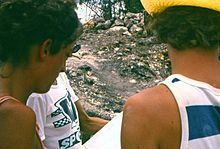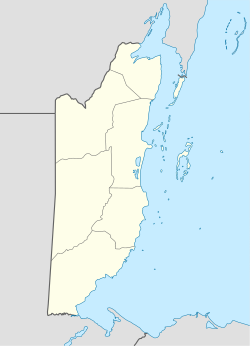 | |
| Location | San Pablo, Orange Walk District, Belize |
|---|---|
| Region | Orange Walk District |
| Coordinates | 18°13′2.48″N 88°35′5.03″W / 18.2173556°N 88.5847306°W |
| History | |
| Founded | c. 350 BC to 250 AD |
| Abandoned | after 10th century |
| Periods | Construction 7th to 10th centuries |
| Cultures | Maya |
Nohmul (or Noh Mul) is a pre-Columbian Maya archaeological site located on the eastern Yucatán Peninsula, in what is today northern Belize. The name Nohmul may be translated as "great mound" in Yucatec Maya. [1] It is the most important Maya site in northern Belize. [2] The site included a large pyramid, about 17 meters (56 ft) tall, [3] built around 250 BC. Most of the pyramid was destroyed in May 2013 by contractors tearing it apart for rocks and gravel to use to fill roads, leaving only the core of the pyramid behind.
History
Nohmul was occupied initially during the Preclassic era of Mesoamerican chronology (c. 350 BC to 250 AD). By the 5th century, monumental construction at the site had effectively ceased and the site seems to have been largely abandoned save for some scattered rural-domestic activities. After a hiatus in construction activities of several centuries, Nohmul was reoccupied and large-scale building resumed, with maximal activity seen during the Late Classic era (c. 7th–10th centuries). The site was densely developed and occupied into the 12th century. [1] [4]
Built above the Hondo River to control the region's trade routes, the site was occupied for centuries. At its height, it was the seat of government for an area spanning approximately 8 square miles (21 km2). [5] Later pre-Columbian residents built structures of the northern Yucatán type over those erected in the Classic era. Some of these more recent constructions covered the front of older stairways. These newer constructions include one that resembles El Caracol, Chichen Itza in Chichén Itzá. These later constructions are evidence supporting the theory that outsiders from the Yucatán settled in Nohmul. [6]
Site description
Nohmul is 10 kilometres (6 mi) north of Orange Walk Town and occupies about 35 square kilometres (14 sq mi) making it the largest Maya site in northern Belize. [7] The site includes about 700 visible mounds ranging from 10 to 30 meters in diameter and from 1 to 5 meters in height. [7]
Nohmul is noted for its unusual layout, with the urban or ceremonial precinct spanning the crest of a limestone ridge overlooking the Hondo River, a permanent river that forms the modern border between Mexico and Belize. The urban precinct consists of two separate clusters of structures, an East Group and West Group, linked by a raised causeway, or sacbe. [7] [4] [6] The East Group is the larger and has been more extensively excavated. [4] The two groups of buildings have a total of ten plazas. Combined, these complexes include more than 80 separate structures. Most of them were constructed either in the Preclassic or Classic period, although there is evidence of additional building activity in the early Postclassic. [6]
Archaeology

The first published reference to Nohmul occurs in Thomas Gann's 1897 paper "On the Contents of Some Ancient Mounds in Central America". Gann performed several excavations at the site between 1908 and 1936. Several of the artifacts collected by Gann are now housed at the British Museum in London. [1] [8]
Prehistoric features at the site were first mapped in 1973 by Norman Hammond. [7] [9] Hammond returned with a small team in the 1980s to do a series of excavations known as The Nohmul Project. [4] [10]
2013 damage
On May 13, 2013, the largest structure at Nohmul was almost completely destroyed. [2] Contractors used excavators and bulldozers to remove large portions of the central pyramid for its limestone content to fill roads in nearby Douglas Village with gravel. Prior to the destruction, the pyramid had a footprint of approximately 50 by 52 meters and was approximately 17 meters tall. [1] [3] More than 70% of the structure was destroyed. [11] The heavy equipment belonged to De-Mar's Stone Company, a company owned by UDP politician Denny Grijalva. [12] Although the structure was on privately owned land, by law, all pre-Columbian sites are under national government protection in Belize.
John Morris of the Belizean Institute of Archaeology said that the workers would have known that they were bulldozing Maya ruins as the tall structure was unmistakable. [13] Jaime Awe, head of the Belize Institute of Archaeology, noted that the pyramid mound could not have been mistaken for a natural hill as the landscape is otherwise flat and the ruins were well-known. [14]
After a lengthy investigation, charges were levied on June 27, 2013 against four individuals: foreman Javier Nunez, excavator driver Emil Cruz, and the managing directors of De-Mar's Stone Company, Denny and Emelda Grijalva. [15] In April 2016, Javier Nunez, Denny Grijalva, and Emelda Grijalva were found guilty on two charges: removing earth from an ancient monument without permission and willfully damaging an ancient monument. Each of them was fined BZ$6000, and the De-Mar's Stone Company was also fined BZ$6000. [16] Denny Grijalva apologized for the destruction and said that his company would work with the government to ensure that it would not happen again. [17]
Similar destruction occurred at the nearby San Estevan site in 2005, as well as at many other ancient sites throughout Belize. [2] Professor Norman Hammond of Boston University, who worked on Belizean archaeological sites extensively during the 1980s, told the Associated Press that "bulldozing Maya mounds for road fill is an endemic problem in Belize". [14]
See also
- El Paraíso, a pyramid in Peru destroyed in 2013 by property developers
Notes
- ^ a b c d "Nohmul". National Institute of Culture and History. Archived from the original on 15 May 2013. Retrieved 16 May 2013.
- ^ a b c Jones, Patrick E.; Mark Stevenson (13 May 2013). "Mayan Nohmul Pyramid In Belize Destroyed By Bulldozer". Huffington Post. Associated Press. Retrieved 16 May 2013.
- ^ a b Pyburn (1988), p. 63.
- ^ a b c d Hammond et al. (1988), pp. 1–2.
- ^ Mahler, Richard (1999). Belize: Adventures in Nature (2nd ed.). Berkeley, Calif.: Publishers Group West. p. 306. ISBN 1562614312.
- ^ a b c Kelly, Joyce (October 1996). Archaeological Guide to Northern Central America: Belize, Guatemala, Honduras and El Salvador. University of Oklahoma Press. ISBN 978-0806128610. Retrieved 14 May 2013.
- ^ a b c d Pyburn (1988), p. 62.
- ^ Pyburn (1988), pp. 65–67.
- ^ Hammond (1973), pp. 34–73.
- ^ Pyburn (1988), p. 76.
- ^ "Did Douglas Chairman Contribute To The Destruction Of Noh Mul?". CTV3 News. 16 May 2013. Archived from the original on 11 August 2013. Retrieved 17 May 2013.
- ^ Vasquez, Jules (10 May 2013). "No More Noh Mul? Contractor Bulldozes Mayan Temple". 7 News Belize. Retrieved 10 May 2013.
- ^ "Mayan pyramid bulldozed by Belize construction crew". BBC News. 14 May 2013. Retrieved 14 May 2013.
- ^ a b "Belizean government vows probe after road crew destroys Mayan pyramid". Fox News. Associated Press. Retrieved 15 May 2013.
- ^ "Denny Grijalva Charged For Noh Mul Mauling". 7 News Belize. 27 June 2013.
- ^ Parks, Rowland A. (23 April 2016). "$24,000 for destroying ancient Mayan temple Noh Mul". Amandala. Retrieved 24 April 2016.
- ^ "Grijalva Sentenced for Destroying Noh Mul". News 5. Belize. 21 April 2016. Retrieved 24 April 2016.
References
- Hammond, Norman; Heighway, C.; Pring, D.; Wilk, R.; Graham, E. (1973). British Museum–Cambridge University Corozal Project, 1973 Interim Report. Cambridge, England: Centre of Latin American Studies.
- Hammond, Norman; Pyburn, K. Anne; Rose, John; Staneko, J.C.; Muyskens, Deborah (Spring 1988). "Excavation and Survey at Nohmul, Belize, 1986". Journal of Field Archaeology. 15 (1). Boston, MA: Boston University – Association for Field Archaeology: 1–15. doi: 10.2307/530126. ISSN 0093-4690. JSTOR 530126. OCLC 8560818.
- Pyburn, Karen Anne (1988). The settlement of Nohmul: Development of a prehispanic Maya community in northern Belize (Thesis). University of Arizona.
External links
-
 Media related to
Nohmul at Wikimedia Commons
Media related to
Nohmul at Wikimedia Commons

